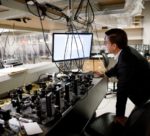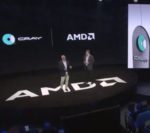Bloomington, IN — The Global Network Operations Center at Indiana University, or GlobalNOC, has signed a four-year agreement in partnership with the Vera C. Rubin Observatory as its inaugural virtual network operations center (VNOC). GlobalNOC will help ensure the transfer of the observatory’s astronomical data from its remote location in Chile to data repositories in the United States and […]
@HPCpodcast: Parallel Processing Systems Pioneer Dr. Thomas Sterling on the State of HPC
Following his highly anticipated and always-insightful closing night keynote at the recent ISC conference, we caught up with Prof. Thomas Sterling to discuss the state of HPC. Dr. Sterling is professor of intelligent systems engineering at Indiana University School of Informatics, Computing, and Engineering, and president and co-founder of Simultac, a technology company focused on […]
Indiana U. Team First to Test Sandia’s Open-Access Quantum Computer
Albuquerque — March 19, 2021 — Sandia National Laboratories has announced its Quantum Scientific Computing Open User Testbed, QSCOUT, is now operational and available for public use. Scientists from Indiana University recently became the first team to use the system. QSCOUT is intended to address limited access to quantum computer technology, which, while poised to […]
Where to Go and What to Do at Virtual SC20: These HPC Experts Give Guidance
As you plan for next week’s Virtual SC20, we thought it would be helpful to ask four HPC industry experts for guidance regarding the sessions, trends, news and other highlights worthy of your attention coming out of what one of our panelists, Dr. Thomas Sterling of the University of Indiana (and of Beowulf cluster pioneering fame), described as “a diverse and rich” program agenda.
NSF awards $696K for Jetstream Project Year 6
Bloomington, IN — The Pervasive Technology Institute at Indiana University has been awarded nearly $700,000 from the National Science Foundation to fund the Jetstream cloud computing system’s sixth project year. This brings the total of NSF funding for Jetstream to nearly $14.5M. These funds will allow for a seamless transition from Jetstream to Jetstream2, recently […]
Jetstream and XSEDE resources available for pandemic research
As part of the worldwide effort to understand and contain the COVID-19 pandemic, Indiana University’s Jetstream, which offers cloud-based, on-demand computing and data analysis resources within the Extreme Science and Engineering Discovery Environment (XSEDE), is fast-tracking projects that respond to the crisis. “Through the COVID-19 HPC Consortium, Jetstream will provide vital high-performance computing resources. Specifically, priority use of IU’s Jetstream cloud system for analysis of the virus and searches for cures and vaccines. Jetstream offers cloud-based, on-demand computing and data analysis resources, in support of research related to COVID-19.”
ISC 2020 Keynotes Focus on Shaping Tomorrow
Today ISC 2020 announced that Mattias Troyer and Thomas Sterling will be keynote speakers at the event. During his keynote, Troyer will describe the hardware and software architectures of quantum computers systems and discuss how they differ from classical HPC systems. Sterling’s closing address this year promises to be more wide-ranging than his usual retrospective, as he traces the intersection of long-term trends involving the diminishing prospects of Moore’s Law, the lengthening lifetimes systems, the consolidation of the HPC market, and the ascent of machine learning.”
Indiana University Launches Quantum Science and Engineering Center
Indiana University has launched a Quantum Science and Engineering Center. The new center will investigate possibilities created by the strange properties of quantum theory, particularly the phenomenon known as quantum entanglement. Within the past two decades or so, scientists have realized that entanglement can revolutionize technologies in fields such as cryptography, computing, and the creation of new materials and sensors. These recent developments hold such promise that some refer to them as the start of the “second quantum revolution.”
Time-lapse Video of Big Red 200 Cray Supercomputer at Indiana University
In this video, technicians install the Big Red 200 supercomputer at Indiana University. IU is the first university to deploy a Cray Shasta system, the Cray Slingshot interconnect and Cray Urika AI Suite for Shasta, providing its engineers, researchers and scientists powerful resources for the next era of computing. The new supercomputer will be instrumental in the University’s exploration and advancement of AI in education, cybersecurity, medicine, environmental science and more.
Video: Cray Steps up with 2nd Generation AMD EPYC Processors for HPC
In this video, from Forrest Norrod from AMD welcomes Peter Ungaro from Cray to discuss how 2nd Generation AMD EPYC processors with drive new levels of performance for HPC. The AMD EPYC 7002 Series Processors are the first x86 server processors featuring 7nm hybrid-multi-die design and PCIe Gen4. With up to 64 high performance cores per SOC, 2nd Gen AMD EPYC Processors deliver world-record performance on industry benchmarks. They are available in the Cray CS500 cluster and Shasta supercomputers.”











